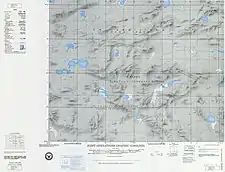Shuanghu County
Shuanghu County (Chinese: 双湖县), also transliterated from Tibetan as Co Nyi County[3][4] (Co'nyi; Tibetan: མཚོ་གཉིས་རྫོང་། ; Chinese: 错尼县; lit. 'twin lake county'), is a county under the jurisdiction of the prefecture-level city of Nagqu, in the northernmost part of the Tibet Autonomous Region, People's Republic of China. It was formed in 2012, combining the territory of the former Shuanghu Special District (Chinese: 双湖特别区) with the eastern half of Nyima County. Much of the county is within the Changtang area.
Shuanghu County
双湖县 • མཚོ་གཉིས་རྫོང་། | |
|---|---|
 Location of Shuanghu Special District (outdated map, situation before 2012) | |
 Shuanghu Location of the seat in the Tibet Autonomous Region | |
| Coordinates: 33°11′32″N 88°50′10″E | |
| Country | People's Republic of China |
| Autonomous region | Tibet |
| Prefecture-level city | Nagqu |
| Area | |
| • Total | 116,700 km2 (45,100 sq mi) |
| Elevation | 4,960 m (16,270 ft) |
| Population (2014) | |
| • Total | 13,470 [2] |
| • Density | 0.12/km2 (0.3/sq mi) |
| Time zone | UTC+8 (China Standard) |
| Shuanghu County | |||||||
|---|---|---|---|---|---|---|---|
| Chinese name | |||||||
| Simplified Chinese | 双湖县 | ||||||
| Traditional Chinese | 雙湖縣 | ||||||
| |||||||
| Alternative Chinese name | |||||||
| Simplified Chinese | 错尼县 | ||||||
| Traditional Chinese | 錯尼縣 | ||||||
| |||||||
| Tibetan name | |||||||
| Tibetan | མཚོ་གཉིས་རྫོང་། | ||||||
| |||||||
Introduction
Shuanghu (Tibetan Tshonyi; mtsho gnyis) translates to "two lakes". Shuanghu County is at very high elevation, mostly above 5,000 meters above sea level, and very sparsely populated (averaging around 0.12 people per square kilometre, but concentrated in the southern portion of the county). The vast majority of its population practices nomadic pastoralism (mostly goats and sheep).[5] The climate is very rough, cold and dry. There is a weather station in Shuanghu, established in 1999,[6] which on average measures negative temperatures (Celsius scale) throughout the year. The highest temperature on record is +2.3 °C (July 2000), the lowest −62.4 °C (January 2006).
Administrative divisions

The county comprises seven town-level divisions: the administrative center at Cuozheluomazhen (Cozhêlhoma, Soggarluma) 措折罗玛镇 (31.902°N 87.887°E), and the six townships Xibdê 协德乡, Yagqu 雅曲乡, Garco 嘎措乡 Cozhêdangma 措折强玛乡, Domar 多玛乡, Parling 巴岭乡.
Purog Kangri Glacier (普若岗日), near Purog Kangri Peak (33.924°N 89.211°E, reported at 6,482 m or 6,435 m)[7] has been reported as the world's largest "third largest glacier" (i.e. the largest outside the two polar regions), at 422 km2 as of 2009, but reportedly melting at "an accelerated rate" (Xinhua).[8]








See also
References
- 世界海拔最高的县--西藏双湖县正式挂牌 (in Chinese). 26 July 2013. Retrieved 26 May 2020.
双湖位于西藏那曲地区西北部,地处羌塘国家级自然保护区腹地,平均海拔5000米。“双湖”是藏语“错尼”(意思为两湖),因地处康如湖和惹角湖而得名。
- Mirenda Wu (23 August 2013). "Book on Tibet's no-man area released". China Tibet Online. Retrieved 27 May 2020.
China's first on-the-spot book on the sparely populated Changtang area in northern Tibet was recently released in the high elevation county Co Nyi of Nagqu Prefecture, the Tibet's Daily reported.{...}The story begins in 1976, 2053 herdsmen from Nagqu Prefecture drove some 160,000 flocks and herds into the then wildness and then set up two county level offices in Co Nyi County and Wombu County. Later, the Wombo County was renamed "Nyima"-the first county in the world in the name of the sun (Nyima means the sun in Tibetan language), and the Co Nyi County was upgraded as Co Nyi Special Zone by the state council.
- "Photovoltaic power station built in Co Nyi County". TibetOL. 14 July 2017. Retrieved 27 May 2020.
- Daniel J. Miller, Nomads of the Tibetan Plateau Rangelands in Western China Part Two: Pastoral Production Practices, Rangelands 21(1) (1999) p. 18.
- accuweather.com
- Not to be confused with the Zangser Kangri Group, 6,460 m. Janusz Majer, Kangri and Jomo Ri Massifs, Reconaissance(sic), Mayer Kangri I East (6,053m) Alpina Americana (2010).
- cas.cn (11 July 2017).
External links
- World's highest county established in Tibet, China.org.cn, July 26, 2013.
